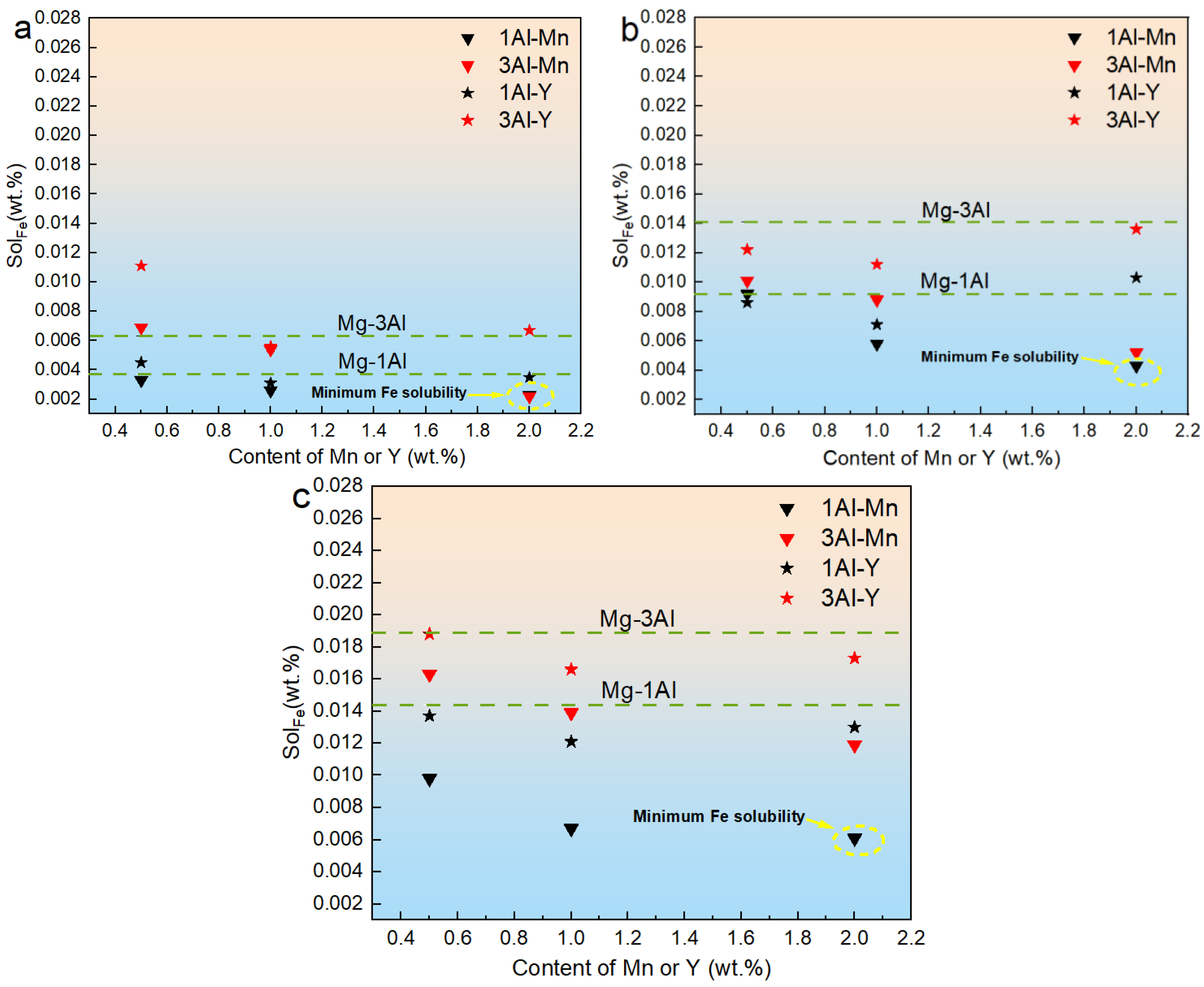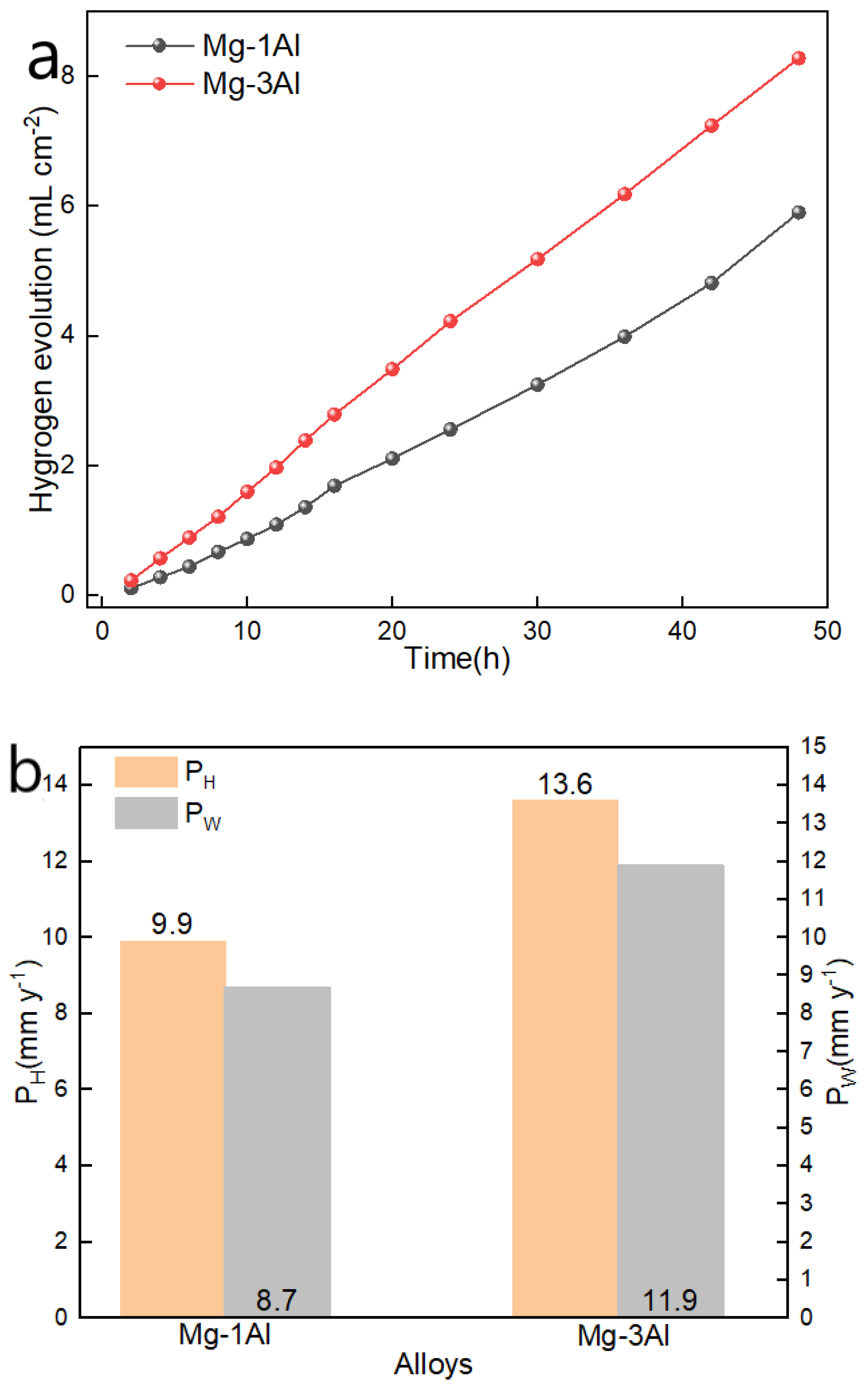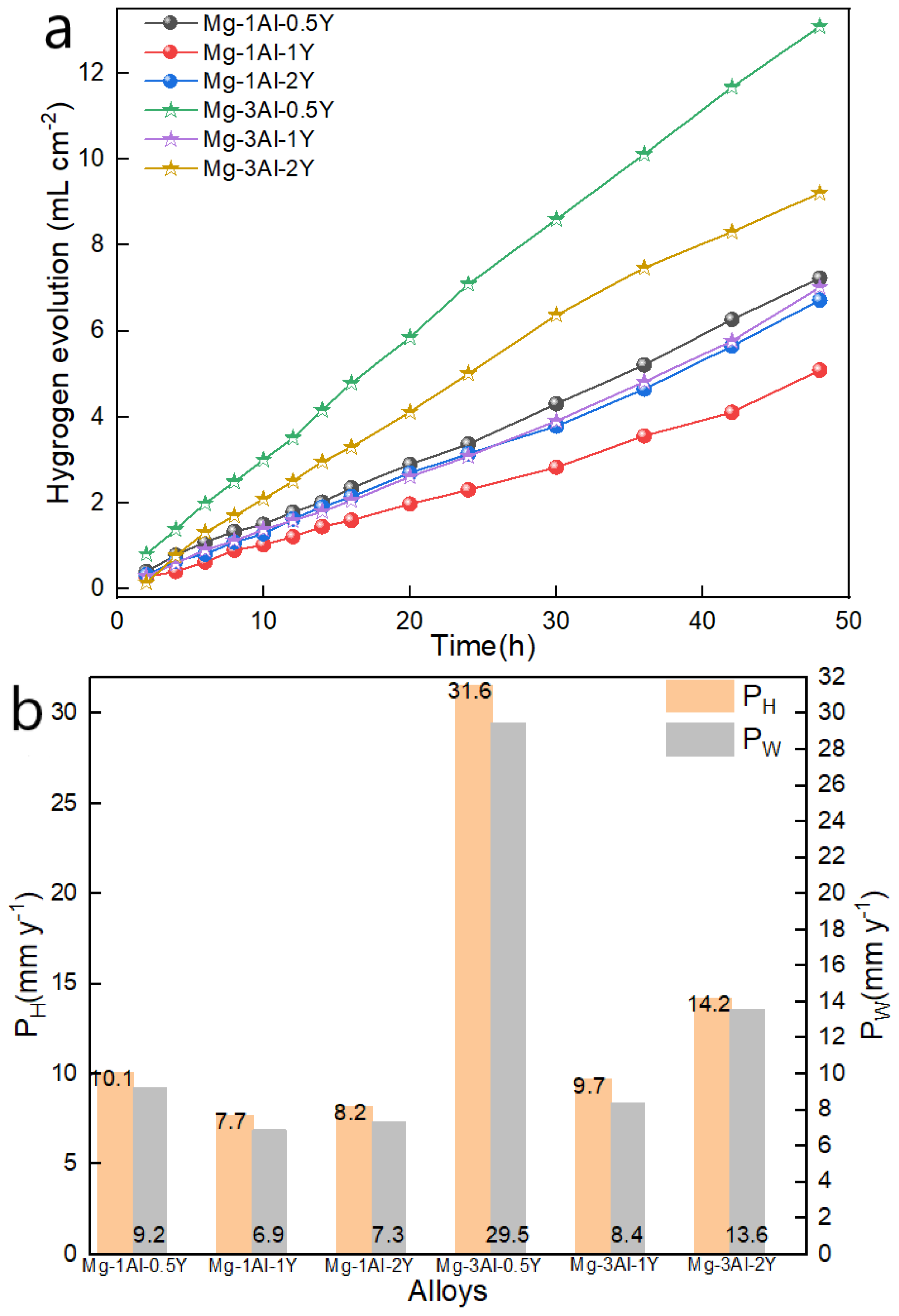Effects of Alloying Elements on the Dissolution and Precipitation Behaviour of Fe in Mg-Al Alloy Melts
Abstract
:1. Introduction
2. Experimental Method
2.1. Materials Preparation
2.2. Characterization Method
3. Results and Discussion
3.1. Comparison of Fe Dissolution Pattern in Mg-xAl-X (X = Mn and Y) Ternary Alloy Melts
3.2. Precipitation Behavior of Fe in the Melt of Mg-3Al-X Alloy
3.2.1. Precipitation Behaviour of Fe in the Melt of Mg-3Al-Mn Alloy
3.2.2. Precipitation Behavior of Fe in the Melt of Mg-3Al-Y Alloy
3.3. Effects of Micro-Alloying on the Corrosion Performance of Mg-Al Alloys
3.3.1. Effects of Al on the Corrosion Performance of Mg Alloys
3.3.2. Effects of Mn on the Corrosion Performance of Mg Alloys
3.3.3. Effects of Y on the Corrosion Performance of Mg Alloys
3.3.4. The Comparison of the Fe Solution Behaviour in the Mg-Al-Mn System and Mg-Al-Y System
4. Conclusions
- (1)
- The solubility of Fe in Mg-Al alloy melts can be reduced by micro-alloying Y or Mn. Additionally, the Fe solubility in the melts is not monotonously dependent on the content of the alloying element. The lowest point of Fe solubility in the Mg-Al-Y ternary alloy melt was at 1 wt.% Y with the same Al content.
- (2)
- There were many precipitations containing Mg, Fe, Al, and X (X = Mn or Y) settled at the bottom of the Mg alloys, which is attributed to the removal of Fe from the melt.
- (3)
- The micro-alloying of Mn and Y of 0.5–2 wt.% can significantly reduce the hydrogen evolution corrosion rates of Mg-Al alloys as both Mn and Y elements can effectively reduce the Fe solubility in Mg-Al alloys and also react with Fe to form less noble intermediate phases. Among the studied alloys, the Mg-1Al-1Mn alloy with the lowest Fe content showed the best corrosion resistance.
Author Contributions
Funding
Data Availability Statement
Conflicts of Interest
References
- Wang, J.; Yuan, Y.; Chen, T.; Wu, L.; Chen, X.; Jiang, B.; Wang, J.; Pan, F. Multi-solute solid solution behavior and its effect on the properties of magnesium alloys. J. Magnes. Alloys 2022, 10, 1786–1820. [Google Scholar] [CrossRef]
- Chen, T.; Gao, Q.; Yuan, Y.; Li, T.; Xi, Q.; Liu, T.; Tang, A.; Watson, A.; Pan, F. Coupling physics in machine learning to investigate the solution behavior of binary Mg alloys. J. Magnes. Alloys 2022, 10, 2817–2832. [Google Scholar] [CrossRef]
- Li, D.; Yuan, Y.; Liu, J.; Fichtner, M.; Pan, F. A review on current anode materials for rechargeable Mg batteries. J. Magnes. Alloys 2020, 8, 963–979. [Google Scholar] [CrossRef]
- Huang, D.; Cao, F.; Ying, T.; Zheng, D.; Song, G.-L. High-energy-capacity metal-air battery based on a magnetron-sputtered Mg–Al anode. J. Power Sources 2022, 520, 230874. [Google Scholar] [CrossRef]
- Fu, Q.; Liang, W.; Huang, J.; Jin, W.; Guo, B.; Li, P.; Xu, S.; Chu, P.K.; Yu, Z. Research perspective and prospective of additive manufacturing of biodegradable magnesium-based materials. J. Magnes. Alloys 2023, 11, 1485–1504. [Google Scholar] [CrossRef]
- Wang, J.; Meng, L.; Xie, W.; Ji, C.; Wang, R.; Zhang, P.; Jin, L.; Sheng, L.; Zheng, Y. Corrosion and in vitro cytocompatibility investigation on the designed Mg-Zn-Ag metallic glasses for biomedical application. J. Magnes. Alloys 2022, 10, 1786–1820. [Google Scholar] [CrossRef]
- Zheng, X.; Song, C.; Yuan, Y.; Li, D.; Gu, D.; Wu, L.; Huang, G.; Wang, J.; Pan, F. High stability In–Sn–Bi multi-element alloy anode for Mg ion batteries. J. Power Sources 2023, 575, 233141. [Google Scholar] [CrossRef]
- Zhang, L.; Yuan, Y.; Wang, J.; Chen, T.; Wang, J.; Pan, F. The ultrahigh damping capacity of Mg-Sn-Y alloy. Scr. Mater. 2023, 233, 115514. [Google Scholar] [CrossRef]
- Li, Y.; Yuan, Y.; Wang, J.; Wu, L.; Cao, F.; Zhang, L.; Pan, F. Controllable degradation behavior of Mg-Sr-Y alloys for the bio-applications. NPJ Mater. Degrad. 2023, 7, 353. [Google Scholar] [CrossRef]
- Cai, L.; Mei, D.; Zhang, Z.-Q.; Huang, Y.-D.; Cui, L.-Y.; Guan, S.-K.; Chen, D.-C.; Kannan, M.B.; Zheng, Y.-F.; Zeng, R.-C. Advances in bioorganic molecules inspired degradation and surface modifications on Mg and its alloys. J. Magnes. Alloys 2022, 10, 670–688. [Google Scholar] [CrossRef]
- Zhu, Q.; Li, Y.; Cao, F.; Qiu, D.; Yang, Y.; Wang, J.; Zhang, H.; Ying, T.; Ding, W.; Zeng, X. Towards development of a high-strength stainless Mg alloy with Al-assisted growth of passive film. Nat. Commun. 2022, 13, 5838. [Google Scholar] [CrossRef]
- Dai, X.; Wu, L.; Ci, W.; Yao, W.; Yuan, Y.; Xie, Z.; Jiang, B.; Wang, J.; Andrej, A.; Pan, F. Dual self-healing effects of salicylate intercalated MgAlY-LDHs film in-situ grown on the micro-arc oxidation coating on AZ31 alloys. Corros. Sci. 2023, 220, 111285. [Google Scholar] [CrossRef]
- Wu, L.; Yang, D.; Zhang, G.; Zhang, Z.; Zhang, S.; Tang, A.; Pan, F. Fabrication and characterization of Mg-M layered double hydroxide films on anodized magnesium alloy AZ31. Appl. Surf. Sci. 2018, 431, 177–186. [Google Scholar] [CrossRef]
- Wu, J.; Yuan, Y.; Yu, X.; Chen, T.; Li, D.; Wu, L.; Jiang, B.; Atrens, A.; Pan, F. The high-temperature oxidation resistance properties of magnesium alloys alloyed with Gd and Ca. J. Mater. Sci. 2021, 56, 8745–8761. [Google Scholar] [CrossRef]
- Wu, J.; Yuan, Y.; Yang, L.; Chen, T.; Li, D.; Wu, L.; Jiang, B.; Steinbrück, M.; Pan, F. The oxidation behavior of Mg-Er binary alloys at 500 °C. Corros. Sci. 2022, 195, 109961. [Google Scholar] [CrossRef]
- Shen, G.; Lyu, S.; Yu, L.; Li, T.; You, C.; Wang, X.; Chen, M.; Jiang, B. Effect of nano-CaO particle on the microstructure, mechanical properties and corrosion behavior of lean Mg-1Zn alloy. J. Magnes. Alloys, 2023; in press. [Google Scholar] [CrossRef]
- Zhang, G.; Wu, L.; Tang, A.T.; Ma, Y.L.; Song, G.L.; Zheng, D.J.; Jiang, B.; Atrens, A.; Pan, F.S. Active corrosion protection by a smart coating based on a MgAl-layered double hydroxide on a cerium-modified plasma electrolytic oxidation coating on Mg alloy AZ31. Corros. Sci. 2018, 139, 370–382. [Google Scholar] [CrossRef] [Green Version]
- Chen, T.; Yuan, Y.; Mi, X.; Wu, J.; Tang, A.; Wang, J.; Moelans, N.; Pan, F.S. Interaction of elements in dilute Mg alloys: A DFT and machine learning study. J. Mater. Res. Technol. 2022, 21, 4512–4525. [Google Scholar] [CrossRef]
- Esmaily, M.; Svensson, J.E.; Fajardo, S.; Birbilis, N.; Frankel, G.S.; Virtanen, S.; Arrabal, R.; Thomas, S.; Johansson, L.G. Fundamentals and advances in magnesium alloy corrosion. Prog. Mater. Sci. 2017, 89, 92–193. [Google Scholar] [CrossRef]
- Lei, Y.; Zhan, M.; Xin, H.; Ma, L.; Yuan, Y.; Zhang, H.; Zheng, Z. Comparison of the Strain Rate Sensitivity in AZ31 and WE43 Magnesium Alloys under Different Loading Conditions. Crystals 2023, 13, 554. [Google Scholar] [CrossRef]
- Chen, T.; Yuan, Y.; Wu, J.J.; Liu, T.T.; Chen, X.H.; Tang, A.T.; Pan, F.S. Alloy Design Strategies of the Native Anti-corrosion Magnesium Alloy. In Magnesium Technology 2019; Springer International Publishing: Berlin/Heidelberg, Germany, 2019; pp. 169–173. [Google Scholar]
- Jiang, S.; Yuan, Y.; Wang, J.; Chen, T.; Wu, L.; Chen, X.; Jiang, B.; Tang, A.; Pan, F. Effect of alloying elements on the dissolution behavior of iron in magnesium melt. Calphad 2022, 79, 102503. [Google Scholar] [CrossRef]
- Cao, F.; Xiao, B.; Wang, Z.; Ying, T.; Zheng, D.; Atrens, A.; Song, G.L. A Mg alloy with no hydrogen evolution during dissolution. J. Magnes. Alloys 2021, 11, 2084–2095. [Google Scholar] [CrossRef]
- Zhang, C.; Wu, L.; Liu, H.; Huang, G.; Jiang, B.; Atrens, A.; Pan, F. Microstructure and corrosion behavior of Mg-Sc binary alloys in 3.5 wt.% NaCl solution. Corros. Sci. 2020, 174, 108831. [Google Scholar] [CrossRef]
- Wang, J.; Yuan, Y.; Zhang, Y.; Feng, X.; Chen, T.; Chen, X.; Jiang, B.; Yang, Y.; Pan, F. A method of removal of nickel impurity from electrolytic magnesium. Vacuum 2022, 203, 111310. [Google Scholar] [CrossRef]
- Liu, M.; Uggowitzer, P.J.; Nagasekhar, A.V.; Schmutz, P.; Easton, M.; Song, G.L.; Atrens, A. Calculated phase diagrams and the corrosion of die-cast Mg-Al alloys. Corros. Sci. 2009, 51, 602–619. [Google Scholar] [CrossRef]
- Makar, G.L.; Kruger, J. Corrosion of Magnesium. Int. Mater. Rev. 1993, 38, 138–153. [Google Scholar] [CrossRef]
- Arora, G.S.; Saxena, K.K.; Mohammed, K.A.; Prakash, C.; Dixit, S. Manufacturing Techniques for Mg-Based Metal Matrix Composite with Different Reinforcements. Crystals 2022, 12, 945. [Google Scholar] [CrossRef]
- Gusieva, K.; Davies, C.H.J.; Scully, J.R.; Birbilis, N. Corrosion of magnesium alloys: The role of alloying. Int. Mater. Rev. 2015, 60, 169–194. [Google Scholar] [CrossRef]
- Ha, H.Y.; Kang, J.Y.; Yang, J.; Yim, C.D.; You, B.S. Role of Sn in corrosion and passive behavior of extruded Mg-5 wt.% Sn alloy. Corros. Sci. 2016, 102, 355–362. [Google Scholar] [CrossRef]
- Yin, H.; Chen, J.H.; Yan, H.G.; Xia, W.J.; Su, B.; Huang, W.S.; Yan, X.X. Effects of Zn Addition on Microstructure, Mechanical, and Corrosion Properties of the As-Solutionized Mg-5Ga Alloy. J. Mater. Eng. Perform. 2021, 30, 4411–4420. [Google Scholar] [CrossRef]
- Chen, T.; Xiong, X.; Yuan, Y.; Tang, A.T.; Li, D.J.; Atrens, A.; Pan, F.S. Effect of Steels on the Purity of Molten Mg Alloys. Adv. Eng. Mater. 2020, 22, 2000338. [Google Scholar] [CrossRef]
- Chen, T.; Yuan, Y.; Liu, T.T.; Li, D.J.; Tang, A.T.; Chen, X.H.; Schmid-Fetzer, R.; Pan, F.S. Effect of Mn Addition on Melt Purification and Fe Tolerance in Mg Alloys. JOM 2021, 73, 892–902. [Google Scholar] [CrossRef]
- Andreatta, F.; Apachitei, I.; Kodentsov, A.A.; Dzwonczyk, J.; Duszczyk, J. Volta potential of second phase particles in extruded AZ80 magnesium alloy. Electrochim. Acta 2006, 51, 3551–3557. [Google Scholar] [CrossRef]
- Byun, J.Y.; Kwon, S.; Ha, H.P.; Yoon, J.K. A Manufacturing Technology of AZ91-Alloy Slurry for Semi Solid Forming. In Magnesium: Proceedings of the 6th International Conference Magnesium Alloys and Their Applications; Wiley-VCH Verlag GmbH & Co. KGaA: Weinheim, Germany, 2005; pp. 713–718. [Google Scholar]
- Chen, Y.; Wu, L.; Yao, W.; Wu, J.; Serdechnova, M.; Blawert, C.; Zheludkevich, M.L.; Yuan, Y.; Xie, Z.; Pan, F. “Smart” micro/nano container-based self-healing coatings on magnesium alloys: A review. J. Magnes. Alloys, 2023; in press. [Google Scholar] [CrossRef]
- Hillis, J. The Effects of Heavy Metal Contamination on Magnesium Corrosion Performance. SAE Trans. 1983, 92, 553–559. [Google Scholar] [CrossRef]
- James, D.W.; Staack, G.C.; Hunyadi Murph, S.E. Tritium Aging of LaNi4.15Al0.85 (LANA.85). Fusion Sci. Technol. 2017, 71, 565–569. [Google Scholar] [CrossRef]
- Luo, A.A. Magnesium casting technology for structural applications. J. Magnes. Alloys 2013, 1, 2–22. [Google Scholar] [CrossRef] [Green Version]
- Liu, L.; Yuan, F.; Zhao, M.; Gao, C.; Feng, P.; Yang, Y.; Yang, S.; Shuai, C. Rare Earth Element Yttrium Modified Mg-Al-Zn Alloy: Microstructure, Degradation Properties and Hardness. Materials 2017, 10, 477. [Google Scholar] [CrossRef]
- Chen, G.; Peng, X.D.; Fan, P.G.; Xie, W.D.; Wei, Q.Y.; Ma, H.; Yang, Y. Effects of Sr and Y on microstructure and corrosion resistance of AZ31 magnesium alloy. Trans. Nonferr. Met. Soc. China 2011, 21, 725–731. [Google Scholar] [CrossRef]
- Matsubara, H.; Ichige, Y.; Fujita, K.; Nishiyama, H.; Hodouchi, K. Effect of impurity Fe on corrosion behavior of AM50 and AM60 magnesium alloys. Corros. Sci. 2013, 66, 203–210. [Google Scholar] [CrossRef]
- Song, J.; She, J.; Chen, D.; Pan, F. Latest research advances on magnesium and magnesium alloys worldwide. J. Magnes. Alloys 2020, 8, 1–41. [Google Scholar] [CrossRef]
- Li, L.; Nam, N.D. Effect of yttrium on corrosion behavior of extruded AZ61 Mg alloy. J. Magnes. Alloys 2016, 4, 44–51. [Google Scholar] [CrossRef] [Green Version]
- Kim, J.I.; Nguyen, H.N.; You, B.S.; Kim, Y.M. Effect of Y addition on removal of Fe impurity from magnesium alloys. Scr. Mater. 2019, 162, 355–360. [Google Scholar] [CrossRef]
- Liao, H.; Kim, J.; Liu, T.; Tang, A.; She, J.; Peng, P.; Pan, F. Effects of Mn addition on the microstructures, mechanical properties and work-hardening of Mg-1Sn alloy. Mater. Sci. Eng. A 2019, 754, 778–785. [Google Scholar] [CrossRef]
- Wu, X.; Jing, X.; Xiao, H.; Ouyang, S.; Tang, A.; Peng, P.; Feng, B.; Rashad, M.; She, J.; Chen, X.; et al. Controlling grain size and texture in Mg–Zn–Mn alloys from the interaction of recrystallization and precipitation. J. Mater. Res. Technol. 2022, 21, 1395–1407. [Google Scholar] [CrossRef]







| Fe | C | Si | Mn | Cr | Cu | Ni | P |
|---|---|---|---|---|---|---|---|
| Bal. | <0.025 | <0.0947 | <0.24 | <0.0204 | <0.0317 | <0.0091 | <0.0118 |
| Nominal Alloy Compositions (wt.%) | Holding Temperature (K) | Mn or Y Content (wt.%) | Fe Content (wt.%) |
|---|---|---|---|
| Mg-1Al-0.5Mn | 963 | 0.3951 | 0.0052 |
| Mg-1Al-1Mn | 0.8325 | 0.0026 | |
| Mg-1Al-2Mn | 1.8152 | 0.0023 | |
| Mg-1Al-0.5Mn | 998 | 0.4016 | 0.0151 |
| Mg-1Al-1Mn | 0.8613 | 0.0038 | |
| Mg-1Al-2Mn | 1.8327 | 0.0043 | |
| Mg-1Al-0.5Mn | 1033 | 0.4108 | 0.0271 |
| Mg-1Al-1Mn | 0.8699 | 0.0067 | |
| Mg-1Al-2Mn | 1.8665 | 0.0061 | |
| Mg-3Al-0.5Mn | 963 | 0.3907 | 0.0117 |
| Mg-3Al-1Mn | 0.8006 | 0.0054 | |
| Mg-3Al-2Mn | 1.7005 | 0.0022 | |
| Mg-3Al-0.5Mn | 998 | 0.4042 | 0.0265 |
| Mg-3Al-1Mn | 0.8102 | 0.0098 | |
| Mg-3Al-2Mn | 1.7056 | 0.0052 | |
| Mg-3Al-0.5Mn | 1033 | 0.4099 | 0.0266 |
| Mg-3Al-1Mn | 0.8257 | 0.0220 | |
| Mg-3Al-2Mn | 1.7167 | 0.0119 | |
| Mg-1Al-0.5Y | 963 | 0.4485 | 0.0045 |
| Mg-1Al-1Y | 0.7352 | 0.0031 | |
| Mg-1Al-2Y | 1.6692 | 0.0035 | |
| Mg-1Al-0.5Y | 998 | 0.4499 | 0.0086 |
| Mg-1Al-1Y | 0.7931 | 0.0071 | |
| Mg-1Al-2Y | 1.6863 | 0.0103 | |
| Mg-1Al-0.5Y | 1033 | 0.4636 | 0.0137 |
| Mg-1Al-1Y | 0.8461 | 0.0121 | |
| Mg-1Al-2Y | 1.7041 | 0.0130 | |
| Mg-3Al-0.5Y | 963 | 0.4011 | 0.0111 |
| Mg-3Al-1Y | 0.8779 | 0.0056 | |
| Mg-3Al-2Y | 1.8581 | 0.0067 | |
| Mg-3Al-0.5Y | 998 | 0.4121 | 0.0122 |
| Mg-3Al-1Y | 0.8764 | 0.0112 | |
| Mg-3Al-2Y | 1.8933 | 0.0136 | |
| Mg-3Al-0.5Y | 1033 | 0.4124 | 0.0188 |
| Mg-3Al-1Y | 0.8898 | 0.0166 | |
| Mg-3Al-2Y | 1.9062 | 0.0173 |
Disclaimer/Publisher’s Note: The statements, opinions and data contained in all publications are solely those of the individual author(s) and contributor(s) and not of MDPI and/or the editor(s). MDPI and/or the editor(s) disclaim responsibility for any injury to people or property resulting from any ideas, methods, instructions or products referred to in the content. |
© 2023 by the authors. Licensee MDPI, Basel, Switzerland. This article is an open access article distributed under the terms and conditions of the Creative Commons Attribution (CC BY) license (https://creativecommons.org/licenses/by/4.0/).
Share and Cite
Jiang, S.; Yang, L.; Yuan, Y.; Zhang, L.; Wang, J.; Chen, T.; Tang, A.; Ma, L.; Pan, F. Effects of Alloying Elements on the Dissolution and Precipitation Behaviour of Fe in Mg-Al Alloy Melts. Metals 2023, 13, 1466. https://doi.org/10.3390/met13081466
Jiang S, Yang L, Yuan Y, Zhang L, Wang J, Chen T, Tang A, Ma L, Pan F. Effects of Alloying Elements on the Dissolution and Precipitation Behaviour of Fe in Mg-Al Alloy Melts. Metals. 2023; 13(8):1466. https://doi.org/10.3390/met13081466
Chicago/Turabian StyleJiang, Shiyu, Li Yang, Yuan Yuan, Ligang Zhang, Jun Wang, Tao Chen, Aitao Tang, Lifeng Ma, and Fusheng Pan. 2023. "Effects of Alloying Elements on the Dissolution and Precipitation Behaviour of Fe in Mg-Al Alloy Melts" Metals 13, no. 8: 1466. https://doi.org/10.3390/met13081466





